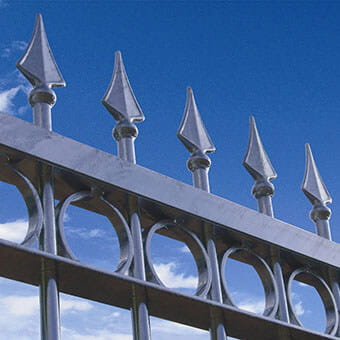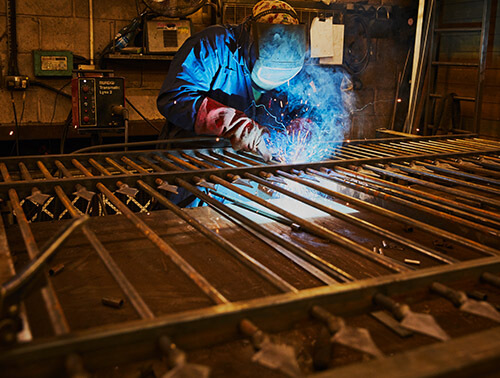Our other sites:
The phrase ‘anti-climb’ fencing is used a lot, but what’s the best type of fencing to protect against this risk? The purpose of anti-climb fencing is to prevent unwanted visitors entering a building or outdoor space by scaling the barrier. There are a great many options on the market, so it helps to explore what’s out there, and how exactly it works to protect your property, so you can specify the right type.
Thanks to advanced design and engineering practices, anti-climb fences don’t have to be toweringly high with barbed wire on top. Anti-climb fencing includes metal railings, vertical bar fencing, mesh security fencing, and timber acoustic barriers; there are plenty of styles to choose from within each range. Each type of fencing performs differently, and each can also satisfy the requirement for objectives such as visibility, strength, noise reduction, and aesthetic value.

For certain sites, such as prisons, data centres, and military bases, protection from climbing is of utmost importance, and aesthetics less so. When securing the perimeter around parks and schools, more attention will likely be paid to the look of the fencing.

Anti-climb fencing features
Naturally, fencing with a solid design and flat profile doesn’t have hand or footholds to aid climbing intruders, so it immediately provides protection to a property. A number of timber acoustic barriers fall into this category as by nature, they need a solid profile with no gaps to prevent noise escaping, and they are generally installed at tall heights. Investment in acoustic security barriers allows property owners or managers to address noise issues as well as provide security. Our acoustic security barriers are often installed to combat noise as well as increase privacy and security at schools, along railways and highways, and around housing estates.

For specialist sites such as data centres or manufacturing facilities, there is often the same need for noise reduction as well as a perimeter security solution. We have combined the two requirements to create our Trident® Jakoustic fencing range, and C5, F1, or G1 rated Jakoustic® Class 3 acoustic barrier using a combination of timber and steel to offer high security options for noise reduction. The solid, flat profile of this fencing product makes it a savvy choice for those needing high anti-climb protection.

Around some sites, visibility takes prevalence over noise reduction, so a semi-solid style of fencing such as mesh or vertical bar is preferable. If you opt for tightly knit mesh for metal fencing, this means there are no spaces for finger holds, which again, will make climbing virtually impossible.

With metal railings, a lack of horizontal rails is advantageous, as rails create a step for intruders. If horizontal rails are necessary for support, they should be at an appropriate distance from the top rail to reduce this issue.

Height matters
Increasing the height of your fencing is another way to prevent your property being accessed. Opting for tall panels and posts is a good way to prevent scaling. Certain heights are required or recommended in different sectors. Read more about standard fence heights.
Additional security toppings
Where appropriate, fence spikes and security toppings can be used to enhance security against climbing and intrusion. Rotating spikes are powerful deterrents, because these add movement and instability, making entry even more difficult.
At Jacksons we have a wide range of security toppings including barbed wire, spikes, and rotary systems for fences, walls and drainpipes. All are designed to deter and deny entry to premises – their presence alone can be enough to dissuade anyone who is tempted to climb.
Be aware though, that the installation of security fence spikes may require planning permission or building regulations approval from your local authority. So, check before you go ahead with these products.
Also, ensure you install a warning sign alongside your fence spikes and security toppings. These will alert visitors and intruders that there are anti climb measures in place, avoiding potential injuries and damaging lawsuits, and acting as a deterrent in their own right.

Adding PIDS – Perimeter Intrusion Detection Systems
Perimeter Intrusion Detection Systems (PIDS) are electronic sensors that detect and alert attempts to cut or climb the perimeter of a property, building or other secured area. When paired with CCTV and intruder alarm systems, they provide an efficient and effective method of detecting intruders.
Our Jaktronic range of PIDS includes multifunctional electronic perimeter intrusion detection and deterrent systems. These would suit any site which requires sophisticated measures to provide early warning of attempts to cut, climb, or vandalise the fence onto which they are mounted.
These PIDS can be easily integrated onto rigid perimeter security fencing, including chain link, mesh panels, vertical bar railings, and security toppings. They are commonly used in the protection of high-end properties, industrial properties, storage facilities, and warehouses, to prisons, government and military sites, and national infrastructure utilities. The PIDS work by a piezoelectric sensor cable which detects activity and sends signals to a seismic analyser.
Which climb protection fencing is suited to which kind of site?
As a rule of thumb, standard security fencing would suit schools and commercial properties; high security fencing would suit data centres and airports; extremely high would suit military sites, government properties and utilities.
Standard anti-climb protection:
Find all the products above in our vertical bar railings range.
Find the products above in our mesh security fencing range.
High anti-climb protection:
Extremely high anti-climb protection:
Find the products above in our high security fencing range.
If you'd like professional advice or a quote for anti-climb fencing please contact us.
Related Products
Jacksons Fencing have a large range of related products, all complete with our 25 year guarantee. If you cannot find the item you are looking for, please do not hesitate to call our friendly sales team.
Related Content
Top






